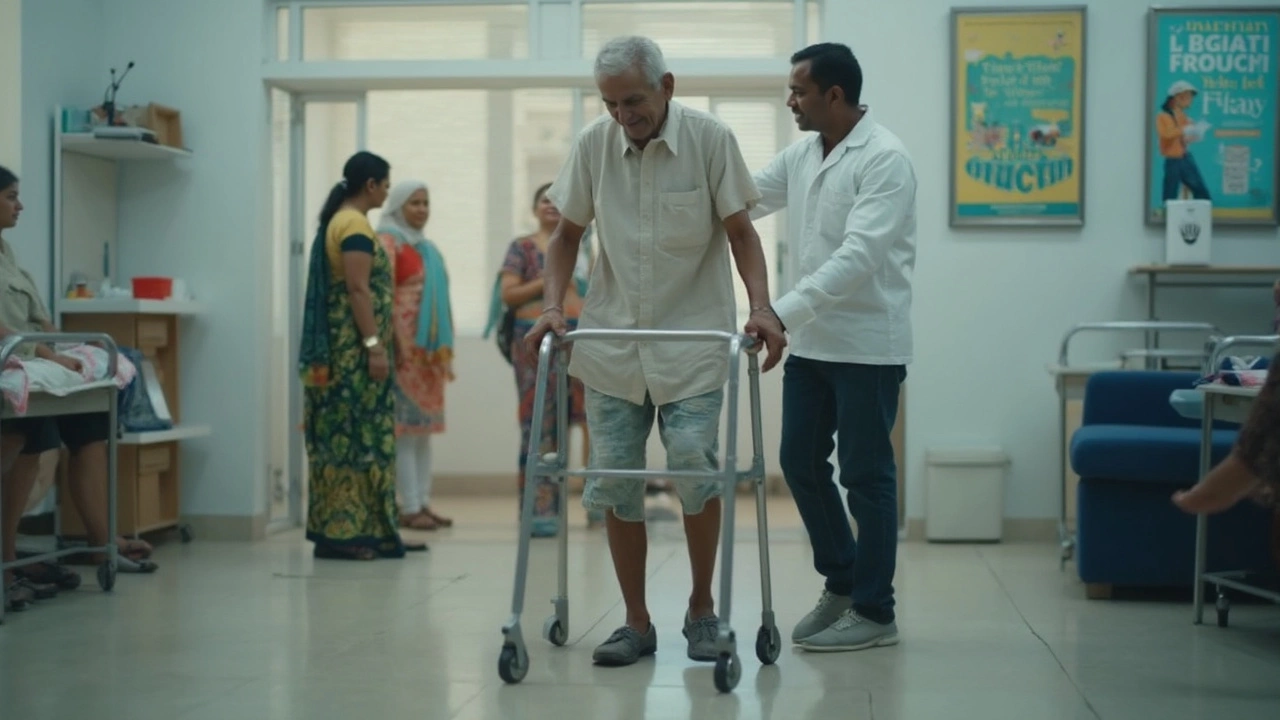Most people hear the words "knee replacement" and instantly think of months stuck on the couch, but the numbers might surprise you. On average, you’re looking at about six weeks to get back to normal, everyday stuff—like cooking or walking the dog (my golden retriever Simba is usually my first rehab buddy, honestly). Getting back to hobbies or work usually takes closer to three months. Some folks even hit their stride in less than that, especially if they’re motivated and stick to their rehab plan.
Don’t believe those stories about people running marathons a month after surgery, though. The kneecap and surrounding muscles need time to heal and get strong. The exact recovery time isn’t a one-size-fits-all deal. Age, overall health, and how active you were before surgery all play a role. If you want to get back on your feet faster, the secret isn’t just about pushing harder—it’s about following your physical therapist’s advice, keeping swelling down, and knowing when to rest.
- How Long Does Knee Replacement Recovery Usually Take?
- What Slows Down or Speeds Up Recovery?
- The First Few Weeks: What You’re Likely to Feel
- Milestones and Setbacks: What to Watch Out For
- Tips to Push Recovery Along and Avoid Common Mistakes
How Long Does Knee Replacement Recovery Usually Take?
If you’re hoping for a quick bounce-back after knee replacement surgery, here’s the reality check: most people need about 6 weeks before they can handle basic stuff easily—walking, standing, even climbing a few stairs. After about 12 weeks, you’ll likely feel ready for more normal life, maybe even getting back to work or a little bit of exercise. But if your job is very physical or you’re eyeing sports, you might need closer to 6 months before you’re cruising along again.
Let’s break it down with a real-life style timeline:
- Day 1-2: You’re up and moving with a walker. Hospital stays are short now, often just 1-3 days.
- Week 2: Most folks can manage short walks inside their home and might switch to a cane.
- Week 4-6: You’ll probably ditch the cane and tackle stairs. Swelling and soreness stick around, but everyday chores are easier.
- Week 12: Light exercise feels doable. A lot of people drive again and go back to desk jobs around this time.
- Months 3-6: Strength and flexibility get much better. Some still have aches or stiffness, but it keeps fading with activity and PT.
Actual numbers from clinics show about 90% of patients recover enough to handle normal daily life in 3 months. But younger patients, regular exercisers, or super-motivated folks sometimes bounce back faster. On the flip side, if you’re managing other health problems, recovery can take a little longer.
| Activity | Average Time Post-Surgery |
|---|---|
| Walking with aid | 2-3 days |
| Walking independently | 2-6 weeks |
| Returning to driving | 4-6 weeks |
| Back to work (desk job) | 4-8 weeks |
| Light sports/exercise | 2-3 months |
| Full high-impact activity | 6+ months |
The main thing: listen to your surgeon and physical therapist. Everyone’s timeline is a bit different, but rushing it usually just sets you back.
What Slows Down or Speeds Up Recovery?
If you’re waiting for your new knee to feel normal, here’s the honest truth: some things make recovery quicker, while others just drag it out. The big players? Age, how strong your legs are, your health before knee replacement, and how serious you take your rehab. I’ve seen neighbors breeze through because they never missed a physical therapy session, while others struggled after skipping the basics.
Let’s chew over what slows things down first. Being overweight, smoking, and not moving enough make everything harder. Complications like infections or blood clots are rare but can add weeks to your recovery time. Ignoring swelling or pain is another classic way to delay healing—small problems get a lot bigger if you just push through.
On the flip side, here’s what speeds things up:
- Starting gentle moves and therapy as soon as the doctor gives a thumbs up
- Keeping your knee iced and elevated to crush swelling
- Sticking to your pain meds schedule so you can hit your physical therapy targets
- Fueling up with enough protein, water, and veggies—healing takes energy
- Following rules about how to sit, stand, and use crutches or a walker
A study from 2023 showed that people who follow their rehab plan closely walk twice as far at the 6-week mark compared to folks who slack. If you want a quick win, take those rehab walks—even if Simba thinks it’s too soon. And don’t underestimate rest; overdoing it can set you back as much as not moving at all.
| Factor | Speeds Up Recovery | Slows Down Recovery |
|---|---|---|
| Following Physical Therapy | ✔️ | ❌ |
| Smoking | ❌ | ✔️ |
| Good Nutrition | ✔️ | ❌ |
| Ignoring Pain or Swelling | ❌ | ✔️ |
| Staying Active (as advised) | ✔️ | ❌ |
Your choices and mindset make a huge difference. The more you control what you can, the smoother that healing process goes.

The First Few Weeks: What You’re Likely to Feel
The first few weeks after a knee replacement can be a roller coaster. Most people wake up after surgery with a big, stiff knee and a pile of questions. It's totally normal to notice swelling, bruising, and soreness in the first days—think of it as your body's way of saying, “Hey, I need some recovery time.”
Getting out of bed the first time isn’t fun. Expect a nurse or therapist to help you stand and shuffle a few steps with support, often within 24 hours of surgery. The main goal in week one is keeping swelling down (ice and elevation help a lot) and starting very simple movements. You’ll probably use a walker or crutches at first. Most people can bend their knee to about 70-90 degrees by the end of week two, but straightening it fully still feels tight and tricky.
Pain isn’t constant, but it comes and goes. Most are surprised that the pain is different from the old arthritis ache—it's a deep soreness with a bit of stiffness. Here’s a snapshot of common milestones and challenges during this phase:
- First 2 days: Hospital stay, plenty of rest, gentle knee bends, and standing with help
- Week 1: Learning to walk with a walker, practicing ankle pumps to keep blood moving, pain managed with meds
- Week 2: Changing dressings, working on bending and straightening, pushing to do more steps around the house, visiting the physical therapist a couple times per week
Watch out for unusual pain, fever, or swelling that keeps getting worse. These can be signs you need to call your doctor right away. Most people are off heavy painkillers within 10-14 days and start switching to over-the-counter options as swelling drops and movement gets easier.
If you’re the kind of person who likes to see the numbers, here’s what a typical recovery timeline looks like in the first few weeks:
| Day | Typical Ability |
|---|---|
| 1 | Stand with assistance, start gentle leg movements |
| 3-7 | Walk short distances with walker or crutches, manage swelling, begin simple exercises |
| 7-14 | Walk around home, do basic exercises, fewer pain meds needed |
The key to this stage? Patience and persistence. Doing too much too soon is just as risky as not moving enough. Following your knee surgery team's advice and listening to your own body gets you through this rough patch the easiest.
Milestones and Setbacks: What to Watch Out For
The road to recovery after knee replacement looks different for everyone, but there are some common milestones people usually hit—plus a few typical bumps that can slow things down. Don’t get discouraged if you don’t move at exactly the same pace as someone else. Here’s what’s typical.
Usual recovery milestones:
- Day 1: Most patients stand up and may take a few steps (with help, of course) the same day as surgery. Physical therapy usually starts within 24 hours.
- Week 1: You’ll probably use a walker or crutches. You might be able to climb stairs slowly, and pain should start becoming more manageable.
- Week 2-3: Stitches or staples usually come out. Swelling is normal but should be dropping. Many switch to a cane and walk around the house more easily.
- Week 4-6: It gets easier to do everyday things like showering, making meals, and walking short distances. Some folks can drive again if off pain meds.
- Month 3: Most bounce back to work (unless it’s a really physical job). Activities like swimming, golf, or longer walks come back on the table.
If you want the cold, hard numbers, check this out:
| Milestone | Typical Timeline |
|---|---|
| Walking unassisted | 4-6 weeks |
| Driving safely | 6-8 weeks |
| Full daily activities | 3 months |
| Forget the joint is artificial | 6-12 months |
Setbacks can happen, though, and they’re not the end of the world. Some things that commonly hold people back include:
- Swelling that doesn’t go away: If your knee’s still ballooned up after a few weeks, talk to your doc. Sometimes you just need to ice and elevate more, but check for signs of infection just in case.
- Stubborn pain or stiffness: Some folks hit a plateau around weeks 3-6. If you’re doing your knee replacement exercises but don’t feel progress, ask your therapist about tweaks or adjustments.
- Feeling tired all the time: Your body is healing a major injury. If exhaustion drags on and you can’t do daily stuff by week 6–8, mention it at your next appointment.
- Missing therapy sessions: Skipping rehab is the fastest way to slow things down. The more you stick to the plan, the quicker you’ll hit those key milestones.
If you’re ever uncertain, don’t tough it out alone. Call your surgeon or physical therapist—catching problems early keeps your recovery time on track.

Tips to Push Recovery Along and Avoid Common Mistakes
If you want to make the most out of your knee replacement recovery time, there are some tricks and truths you really don’t want to miss. The fastest recoveries aren’t magic—they come down to a good plan, a dash of patience, and skipping the typical blunders.
- Don’t skip physical therapy—ever. Your knees won’t get their groove back if you try to wing it yourself. Stick to your prescribed routine, even on days you’re tired. Consistency counts more than pushing too hard just once.
- Ice and elevate that knee anytime you start to feel swelling. Swelling not only slows you down, but it also makes bending and straightening super tough.
- Move a little, often. Try not to sit in one spot for hours. Short, regular walks (even in your hallway) help blood flow and keep things from stiffening up.
- Don’t compare your recovery to anyone else’s. Social media makes it look like everyone’s jogging in a month. Most people need 2-3 months to get back to activities like cycling or hiking. Here’s a quick look at some timeline stats:
| Milestone | Average Time After Surgery |
|---|---|
| Off strong pain meds | 2-3 weeks |
| Walking unaided | 4-6 weeks |
| Driving again | 4-6 weeks (if left knee, and automatic car) |
| Low-impact sports | 12 weeks or longer |
- Don’t overdo it on stairs or uneven ground early on. Falls are a top reason people end up back in the hospital after knee surgery.
- Stick with a balanced diet and stay hydrated. Your body does most of its healing when it’s fueled up right—think protein and veggies, not just toast and tea.
- Watch out for warning signs like unusual redness, heat, or fever. If your knee swells up suddenly or you get a weird pain, it’s time to call your doctor and not tough it out.
Avoiding mistakes is just as key as doing the right stuff. Biggest slip-ups? People sometimes ditch their walking aids too soon, ignore small pains hoping they’ll vanish, or skip follow-up visits. If you keep it simple, listen to your body, and trust your medical team, you’ll give yourself a real shot at a smooth recovery.
